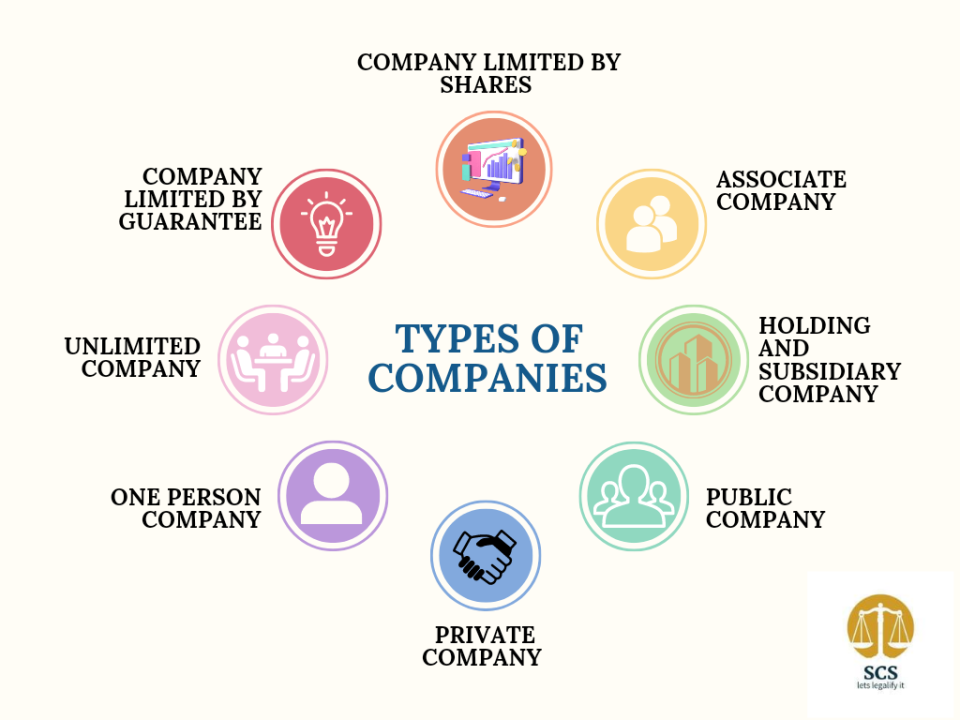View News
Beyond-Public-and-Private-A-Detailed-Look-at-Various-Company-Structures

Beyond Public and Private: A Detailed Look at Various Company Structures
Introduction
The business world thrives on a rich tapestry of structures, extending far beyond the simple dichotomy of public and private companies. This exploration delves deeper, unveiling a spectrum of organizational forms, each with its own advantages, limitations, and target audience. Whether an aspiring entrepreneur, a seasoned investor, or simply curious about the intricate mechanisms that drive the economy, understanding these diverse company structures is crucial. Section 2 of the Companies Act, 2013 provides the definitions of various terms used in the Act, including the definition of various types of companies. Companies may be classified from different points of view as follows.
Kinds of Companies According to the Mode of Incorporation
According to the mode of incorporation, a company may be:
-
Statutory Company: These companies are governed by the special Act under which they are formed. Examples include the Reserve Bank of India, Life Insurance Corporation, and Unit Trust of India. Statutory companies are not required to have a memorandum of association, and the word 'limited' is not part of their names.
-
Registered Company: Companies registered under the Companies Act are known as 'registered' or 'incorporated' companies. They are also governed by special Acts, such as the Banking Regulation Act, 1949, Insurance Act, 1938, and Electricity Act, 2003.
-
Chartered Company: Companies incorporated under a special charter granted by the King or Queen of England. Examples include the East India Company (1600) and the Bank of England (1694). This type of company is no longer formed today.
Kinds of Registered Companies on the Basis of Liability of Members
On the basis of the liability of the members, companies may be:
-
Companies Limited by Shares (Section 2(22)): The liability of members is limited to the amount unpaid on their shares. Most Indian companies fall under this category.
-
Companies Limited by Guarantee (Section 2(21)): The liability of members is limited to the amount they undertake to contribute to the assets of the company in the event of winding up.
-
Unlimited Companies (Section 2(92)): There is no limit on the liability of members, who are personally liable for the company's debts if its assets are insufficient to meet them. Liability is enforceable only at the time of winding up.
Kinds of Registered Companies on the Basis of Number of Members
On the basis of the number of members, a registered company may be:
-
Private Company (Section 2(68)): A private company restricts the right to transfer its shares, limits the number of its members to 200, and prohibits any public invitation to subscribe for its securities.
-
Public Company (Section 2(71)): A public company is not a private company and must have a minimum of seven members with no maximum limit.
-
One Person Company: A company that has only one person as its member.
Kinds of Registered Companies on the Basis of Management Control
On the basis of management control, companies may be classified as:
-
Holding Company (Section 2(46)): A company that controls the composition of the Board of Directors or more than half of the total voting power of one or more subsidiary companies.
-
Subsidiary Company (Section 2(87)): A company controlled by a holding company.
-
Government Company (Section 2(45)): A company in which not less than 51% of the paid-up share capital is held by the central government, state government(s), or both.
-
Associate Company (Section 2(6)): A company in which another company has a significant influence but which is not a subsidiary.
Classification of Companies on the Basis of Place of Registration
On the basis of place of registration, companies may be classified as:
- Indian Company: Incorporated under the Companies Act, 2013 or previous company law in India.
- Foreign Company (Section 2(42)): Incorporated outside India but has a place of business in India and conducts business activities in India.
Other Types of Companies
Other types of companies include:
-
Small Company (Section 2(85)): A company with a paid-up share capital not exceeding fifty lakh rupees and turnover not exceeding two crore rupees.
-
Company with Charitable Objects (Section 8): A company with charitable objectives, not required to include "Limited" or "Private Limited" in its name.
-
Dormant Company (Section 455): A company formed for a future project or to hold an asset or intellectual property that has no significant accounting transactions.
-
Producer Company (Part IXA of the Companies Act, 1956): A company dealing with multi-state cooperative societies, focusing on mutual assistance principles.
Conclusion
The business landscape extends far beyond the simple public vs. private company dichotomy. This exploration has unveiled a rich tapestry of structures, each with its own advantages and considerations. From the flexibility of partnerships to the social impact focus of cooperatives, the choice of structure hinges on a company's unique goals, ownership preferences, and risk tolerance.
"Unlock the Potential of Legal Expertise with LegalMantra.net - Your Trusted Legal Consultancy Partner”
Article Compiled by:-
~Prerna Yadav
(LegalMantra.net Team)
Disclaimer: Every effort has been made to avoid errors or omissions in this material in spite of this, errors may creep in. Any mistake, error or discrepancy noted may be brought to our notice which shall be taken care of in the next edition In no event the author shall be liable for any direct indirect, special or incidental damage resulting from or arising out of or in connection with the use of this information Many sources have been considered including Newspapers, Journals, Bare Acts, Case Materials , Charted Secretary, Research Papers etc.

